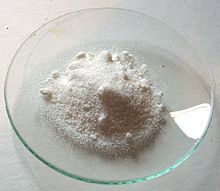


| |
| Names | |
|---|---|
| IUPAC name
Ammonium docosaoxoheptamolybdate(6–) | |
| Other names
Ammonium molybdate | |
| Identifiers | |
|
| |
3D model (JSmol) |
|
| ChemSpider |
|
| ECHA InfoCard | 100.031.553 |
| EC Number |
|
PubChem CID |
|
| UNII |
|
CompTox Dashboard (EPA) |
|
| |
| |
| Properties | |
| (NH4)6Mo7O24 | |
| Molar mass | 1163.9 g/mol 1235.86 g/mol (tetrahydrate) |
| Appearance | white solid |
| Density | 2.498 g/cm3 |
| Melting point | ~90 ˚C (loses water molecule) 190 °C (decomp.) |
| 65.3 g / 100 ml (tetrahydrate) | |
| Hazards | |
| Occupational safety and health (OHS/OSH): | |
Main hazards |
Irritant |
| NFPA 704 (fire diamond) | |
| Flash point | Non-flammable |
| Safety data sheet (SDS) | External MSDS |
| Related compounds | |
Other anions |
Ammonium orthomolybdate Ammonium dimolybdate |
Other cations |
Potassium paramolybdate |
Related compounds |
Molybdenum(VI) oxide Molybdic acid |
Except where otherwise noted, data are given for materials in their standard state (at 25 °C [77 °F], 100 kPa). | |
Ammonium heptamolybdate is the inorganic compound whose chemical formula is (NH4)6Mo7O24, normally encountered as the tetrahydrate. A dihydrate is also known. It is a colorless solid, often referred to as ammonium paramolybdate or simply as ammonium molybdate, although "ammonium molybdate" can also refer to ammonium orthomolybdate, (NH4)2MoO4, and several other compounds. It is one of the more common molybdenum compounds.[1]
Ammonium heptamolybdate is easily prepared by dissolving molybdenum trioxide in an excess of aqueous ammonia and evaporating the solution at room temperature. While the solution evaporates, the excess of ammonia escapes. This method results in the formation of six-sided transparent prisms of the tetrahydrate of ammonium heptamolybdate.[2]
Solutions of ammonium paramolybdate react with acids to form molybdic acid and an ammonium salt. The pH value of a concentrated solution will lie between 5 and 6.
The compound was first analyzed crystallographically by Lindqvist, but has been reanalyzed.[3] All Mo centers are octahedral. Some oxide ligands are terminal, some doubly bridging, and a few are triply bridging ligands.

Potassium heptamolybdate, also obtained as the tetrahydrate, is very similar to the ammonium salt.[3]
Molybdates are typically of low toxicity, so much so that few reports of incidents have ever been reported.[1]
Phosphate test aka Deniges' method links to here.